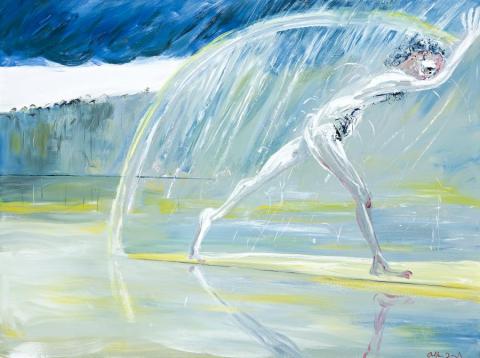NARCISSUS RUNNING ON A SANDBANK, 1976
ARTHUR BOYD
oil on canvas
92.0 x 122.0 cm
signed lower right: Arthur Boyd
Fischer Fine Art, London
Savill Galleries, Sydney
Private collection, Melbourne, acquired from the above in 1995
Arthur Boyd: Recent Paintings, Fischer Fine Art, London, 1977, cat. 13 (illus. in exhibition catalogue)
According to the oft-quoted version ascribed to Ovid, the myth of Narcissus tells of the unrequited love of the nymph Echo who, condemned by Hera to repeat only the last syllable of words spoken in her presence, is unable to declare her love for the handsome youth, Narcissus. Thus spurned by Narcissus, she dies of a broken heart, while Narcissus is doomed by the gods to fall in love with his own image. Unable to tear himself away from his reflection in a woodland pool, he dies there of languor and ultimately, is metamorphosed into the flower which bears his name, growing by the edge of rivers and ponds. With its themes of vanity, self-indulgence and eventually, self-destruction, this epic tale had provided inspiration to the visual arts for thousands of years from ancient Rome to the celebrated images of artists as diverse as Caravaggio, Poussin and Dali. Even local predecessors such as Sydney Long had equipped the Australian bush with Arcadian pastoral idylls in the classical tradition. No artist however, had ever devoted himself to imagining the experiences of Narcissus in the Australian landscape with such vigour and complexity before modernist painter, Arthur Boyd.
Comprising by far the largest body of work on a single theme executed by Boyd during his Shoalhaven period, the Narcissus series " exemplified magnificently here by Narcissus Running on a Sandbank,1976 "was conceived following the artist's return to Australia from England in 1975. Directly inspired by his experience of living upon the banks of the Shoalhaven" the river with its stillness and mesmerising reflections, the ubiquitous native rock orchids, and the haunting echoes of the valley " uch compositions are widely acclaimed among his most audacious works, demonstrating Boyd at his most elegant and commanding. Switching emphasis constantly, at times Boyd allows the naked figure of the doomed Narcissus to dominate (as here where the self-loving spirit strides through the sandbank lashed by a rainstorm and framed by a resplendent rainbow), and elsewhere, the primordial landscape. Pervading the entire series however, is the artist's enduring interest in man and his responsibility to others; as Boyd muses, 'It is the self-absorption of Narcissus that interests me. He was more interesting than Ajax or Hector or Mars. Conceit is essentially non-productive in all aspects...'1 Indeed, for Boyd, Narcissus personifies the concept famously explored by Freud of a self-knowledge that threatens to become impotent self-love and self-destruction. Such moral implications are poignantly reiterated by a similar composition entitled simply Narcissus which features the almost airborne protagonist diving into the water, while behind him, curled up in a foetal position is his own image at birth. Narcissus is so non-productive that he doesn't even notice himself (the foetal baby beside him), while in Narcissus with Cain and Abel on the Shoalhaven, the message is even more poignantly accentuated: 'Cain and Abel were the beginning of non-productive behaviour and Narcissus was a continuation. Both situations are barren.'2
Accompanying the first exhibition of Boyd's 'Narcissus' paintings at Fischer Fine Art, London in 1977, was an introduction by esteemed Australian expatriate poet, Peter Porter, who was motivated to write 'Narcissus Nowra' after visiting the artist at his Shoalhaven property in 1975. Driven by a similar desire to contribute to contemporary issues of morality and politics through the guise of the European cultural tradition, the two would later collaborate on several publications together, including Narcissus (1984) featuring Porter's poems from 1976-79 and Boyd's brilliant visionary suite of 24 aquatint etchings.
1. Boyd cited in McGrath, S., The Artist and The River: Arthur Boyd and The Shoalhaven, Bay Books, Sydney, 1982, p. 69
2. Boyd, cited ibid.
VERONICA ANGELATOS
